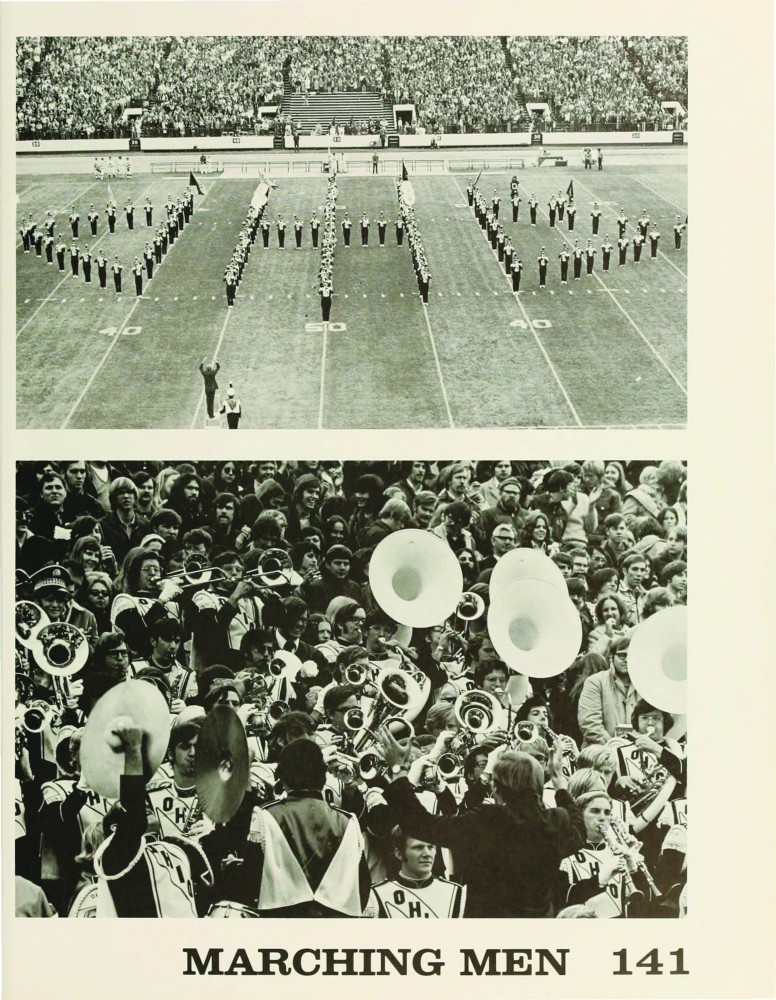Landing Page
Special Projects
This story is part of a series of specially designed stories that represents some of the best journalism The Post has to offer. Check out the rest of the special projects here.


10.05.17
Since its inception in 1923, the Ohio University Marching Band emulated the polished, formal style of an Ivy League marching band. The men wore green blazers, gray slacks and striped ties. Women wore the same uniform with gray skirts. Halftime performances featured traditional military marching tunes.
But in 1967, the OU Marching Band became something entirely new.
When Gene Thrailkill took the reins as director of the marching band, he knew it was time for a change. Prompted by university leadership, Thrailkill used his own experiences in the University of Michigan marching band to mold OU’s band into something more contemporary and exciting.
No longer did the band adhere to the rigid style of the Ivy League. Blazers were replaced with jackets and capes. Traditional songs were abandoned for pop and jazz charts, like “Train of Thought” and “Long Train Running.” And all women were removed from the band to create what was known as the Marching Men of Ohio.
The decision to be a male-only group was met with some opposition. Thrailkill held his ground, defending his position by asserting that all Big 10 bands, like the University of Michigan, were composed of only men. Just seven years later, women were welcomed back and the band was once again co-ed.
This year marks the 50th anniversary of the beginning of the Marching Men of Ohio and the stylistic evolution of the band into what is known today as the Marching 110. Up to 1,000 alumni band members are expected to return to Athens for Homecoming to celebrate the milestone and reflect on the memories they made during their time in the band.
Josh Boyer, assistant director of the Marching 110, said though removing women from the band was a divisive decision made in 1967, the band wishes to celebrate it as a formative year.
“Yes, it was part of the change of the band and the style of the band,” he said. “But the celebration is really focused on the 50 years of the uniform and marching style and all that we embody as the Marching 110 today.”
Charlie Marty, a bass drummer during his days, was a member of the marching band from 1972 to 1975. His first three years of involvement fell during the Marching Men of Ohio era; during his senior year, women were reintroduced to the band.
Marty has looked forward to returning to Athens for Homecoming each autumn for the past few years, and in recent years, has been a helpful instrument in getting other Marching Men of Ohio alumni to return as well. In 2014, he formed a Facebook group specifically for those men who marched during the seven-year period as a way to connect and remember the good old days.
“I was on a couple of the other marching band pages and I just really kind of … didn’t fit in,” Marty said. “A few of us from that era were talking about different things, and we just thought it might be a pretty cool idea to contact as many people as we could from that era and get them all on our page.”
More than 200 members use the page to reminisce on their time in the band, share old photos and plan meetups at Homecoming. Marty said in the years since the formation of the Facebook page, the Marching Men of Ohio alumni have been better organized, and he has been happy to see many more of his old friends during his visits to Athens.
“You really get to know people through a common bond, and it’s more of a brotherhood I think,”Martin Osborne, a member of the Marching Men of Ohio from 1970 to 1975.
“When you show up to Homecoming and there’s not a lot of people you know, it’s a strange feeling,” Marty said. “And I think that’s what this Facebook page has done — it’s really got everybody talking, and you made a lot of new friends even though you were in the band 50 years ago.”
Martin Osborne, a euphonium player in the band, was a member of the Marching Men of Ohio from 1970 to 1975. He said the members of the Facebook group often use the page to dispel misinformation about what happened during their years in the band.
“We ourselves wanted to clear that up through discussion among ourselves … without the people who have no idea what the band did during those years sticking their nose in,” he said. “We actually were there.”
Osborne has dedicatedly worked to find and invite as many former Marching Men to join their group and reconnect with them. He has scoured the internet for mailing and email addresses of the men he connected with through music all those years ago.
“You really get to know people through a common bond, and it’s more of a brotherhood I think,” Osborne said. “We became extremely good friends for life.”
Boyer, who himself is an OU and Marching 110 alumnus, said remembering the band’s history, especially this year, is a special part of Homecoming for all current and former students.
“We all shared the same experiences at Ohio University that were such a big part of our lives,” Boyer said regarding members of the band. “I think that’s something that we cherish, but also I think … the general student body cherishes because we are a part of everybody’s Ohio University experience, even if they weren’t a part of the band. I think that’s an important part of what makes Ohio University special.”
A previous version of this report misspelled the names of the first Marching 110 director Gene Thrailkill and almnus Charlie Marty. The article has been updated to reflect the most accurate information.
Landing Page
This story is part of a series of specially designed stories that represents some of the best journalism The Post has to offer. Check out the rest of the special projects here.